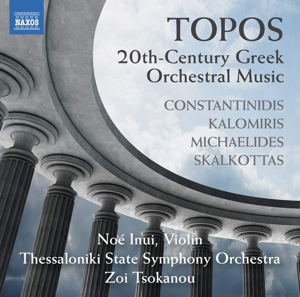
Topos – 20th-Century Greek Orchestral Music
Solon Michaelides (1905-1979)
Avgi ston Parthenona (Dawn at the Parthenon) (1934/36)
Manolis Kalomiris (1883-1962)
Nissiotikes zografies (Island Pictures) (1928/39)
Yannis Constantinidis (1903-1984)
Dodecanesian Suite No. 1 (1948)
Dodecanesian Suite No. 2 (1949)
Nikos Skalkottas (1904-1949)
Five Greek Dances (1933/36, arr. 1938-47, ed. string orchestra Walter Goehr)
Noé Inui (violin), Thessaloniki State Symphony Orchestra/Zoi Tsokanou
rec. 2021, Thessaloniki Concert Hall, Greece
Naxos 8.574436 [66]
Anticipation can be a double-edged sword. I was greatly looking forward to hearing Víkingur Ólafsson’s Goldberg Variations and was disappointed. On the other hand, I had no expectations at all about this Naxos release, and yet I found myself enjoying it greatly.
I should say that before I requested it for review, I did read the description on the Presto Classical page (taken from the CD back cover), which cited connections to Impressionism and Rimsky-Korsakov. I hoped that this was be somewhere close to the truth; these are, after all, works from the 1930s and 40s and could easily have been hard-edged and atonal. “Topos” means “place” or “land” in Greek, and each of these five works has a strong association with Greece.
Solon Michaelides founded the orchestra that plays on this recording; you can’t get much more authentic than that. He was another student of Nadia Boulanger, and his early works, such as Dawn at the Parthenon which was written whilst he was still in Paris, have a strong air of French Impressionism. In its six minutes, it evokes very effectively sunrise, birdsong and Mediterranean sunshine.
Rimsky-Korsakov’s Scheherazade made a great impression on Manolis Kalomiris when he heard it for the first time, and the result of that impression can be heard throughout his Island Pictures (also known as Suite on Motifs from the Dodecanese). The three movements feature a substantial part for solo violin, and while the work does not have quite the same level of inspiration as its Russian model, there is a great deal to enjoy across its changing moods.
Like Kalomiris, Yannis Constantinidis was born in what is now mainland Turkey, in the Greek-controlled city of Smyrna (now İzmir). Both were strongly influenced by the folk music of the Dodecanese Islands, a chain of 150 small islands belonging to Greece, off the southwestern coast of Turkey, the best known of which is Rhodes. Kurt Weill, one of Constantinidis’s teachers in Berlin, praised his handling of the orchestra, and there is no doubt that the scoring in the two suites is quite exquisite. Again Rimsky-Korsakov comes to mind, but better absorbed than in the Kalomiris. Quite a discovery then, but sadly this seems to be the only recording of his orchestral music available.
Nikos Skalkottas is, by some margin, the best known of the four composers here. He was a student of Schoenberg and a proponent of atonal music, so I am not sure whether I had heard any of his music before. However, he did also write tonal music, as evidenced in his Greek Dances. He wrote thirty-six of them in all, arranging some for string quartet, and these were further arranged for string orchestra by his classmate Walter Goehr. As you would expect from string music, the orchestral palette is reduced, compared to the other pieces on the disc. There is also a little more vinegar added to the harmonies, but that makes for a good crisp ending to the disc.
The orchestra plays very well, giving the dance rhythms great energy, and providing finesse where delicacy is required. The booklet notes and the sound are both excellent. Zoi Tsokanou was the first woman to lead a major Greek orchestra, taking the reins at Thessaloniki in 2017, and this would seem to be her first recording. On the basis of these fine performances, I hope more will soon be forthcoming.
So rather out of the blue (Greek pun intended), a hugely enjoyable release.
David Barker
Help us financially by purchasing from





















